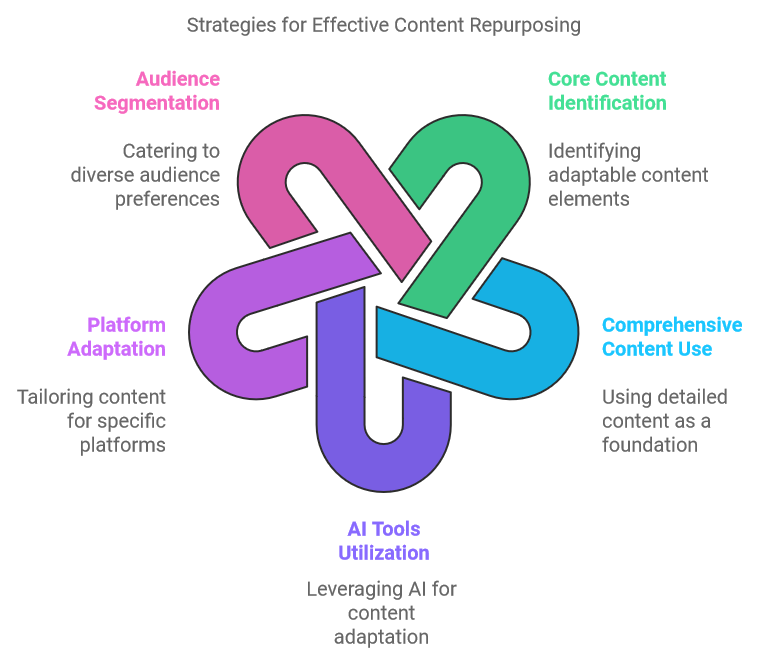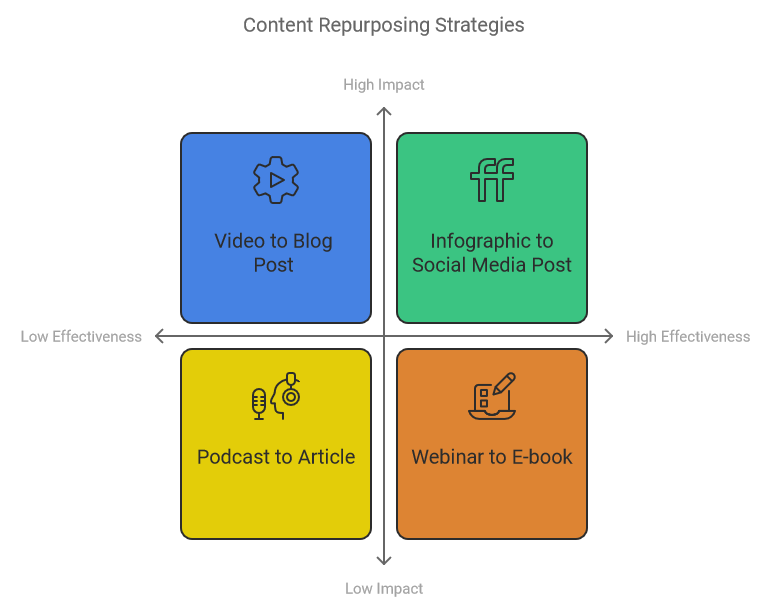Master Content Repurposing 🚥
Turn Dusty Blogs Into Gold Mines with These Repurposing Secrets 🤫
In the ever-evolving digital landscape, content creators are constantly seeking innovative ways to maximize the reach and impact of their work.
Whether you're a YouTuber, blogger, or digital marketer, the ability to repurpose content effectively can be a game-changer.
This eBook delves into the art and science of content repurposing, offering insights and strategies to help you transform your existing digital assets into powerful tools for engagement and growth.
The concept of content repurposing is not new, but with the advent of advanced AI tools and platforms, the possibilities have expanded exponentially.
From turning YouTube videos into blog posts to converting webinars into podcasts, the opportunities to reach new audiences and enhance your digital presence are endless.
This eBook will guide you through the process, providing practical advice and real-world examples to illustrate the potential of content repurposing.
Throughout this eBook, we will explore various methods and tools that can help you repurpose your content efficiently.
We'll discuss the benefits of transforming long-form content into bite-sized social media posts, creating infographics from data-heavy articles, and using customer testimonials as social proof.
By the end of this eBook, you'll have a comprehensive understanding of how to leverage your existing content to drive traffic, increase engagement, and ultimately achieve your digital marketing goals.
Join us on this journey to unlock the full potential of your digital content and discover how repurposing can lead to greater visibility, credibility, and success in the digital world.
Chapter 1: Understanding the Foundations of Content Repurposing
Content repurposing is a strategic approach to maximizing the value of your digital assets by transforming them into different formats and distributing them across various platforms.
At its core, content repurposing is about efficiency and creativity—taking what you already have and adapting it to reach new audiences and achieve different objectives.
The concept of repurposing content has been around for decades, but it has gained significant traction in recent years due to the proliferation of digital platforms and the increasing demand for diverse content formats.
In the past, content creators primarily focused on producing new content to keep their audiences engaged.
However, with the rise of social media, video platforms, and podcasts, the need to repurpose existing content has become more apparent.
One of the key benefits of content repurposing is its ability to extend the lifespan of your content.
Instead of letting a blog post or video fade into obscurity after its initial release, repurposing allows you to breathe new life into your content by presenting it in a fresh and engaging way.
This not only helps you reach new audiences but also reinforces your message to existing followers.
Moreover, content repurposing can significantly enhance your SEO efforts.
By creating multiple pieces of content around a single topic, you can increase your chances of ranking higher in search engine results.
This is particularly important in today's competitive digital landscape, where visibility is crucial for success.
To effectively repurpose content, it's essential to understand the different formats and platforms available.
From blog posts and videos to podcasts and infographics, each format has its unique strengths and audience preferences.
By tailoring your content to suit these formats, you can ensure that your message resonates with your target audience and achieves the desired impact.
In the following chapters, we will explore various strategies and tools for repurposing content, providing you with the knowledge and skills needed to transform your digital assets into powerful marketing tools.

Chapter 2: Key Strategies for Effective Content Repurposing
To successfully repurpose content, it's essential to have a clear strategy in place.
This involves identifying the core elements of your content that can be adapted to different formats and platforms.
By understanding the key components of your content, you can create a cohesive and effective repurposing plan that maximizes its impact.
One of the most effective strategies for content repurposing is to start with a comprehensive piece of content, such as a long-form blog post or a detailed video.
This serves as the foundation for your repurposing efforts, providing a wealth of information and insights that can be adapted into various formats.
For example, a blog post on social media strategies can be transformed into a series of short videos, each focusing on a specific tactic or tip.
Another key strategy is to leverage the power of AI tools to streamline the repurposing process.
Tools like Vidyo.ai and OpusClip can automatically generate short video clips from longer videos, making it easy to create engaging content for platforms like Instagram and TikTok.
Similarly, AI-powered writing tools can help you transform transcripts into well-crafted blog posts or social media updates.
When repurposing content, it's important to consider the unique characteristics of each platform.
For instance, social media platforms like Twitter and Instagram favor concise, visually appealing content, while platforms like LinkedIn and Medium are more suited to in-depth articles and thought leadership pieces.
By tailoring your content to suit the preferences of each platform, you can increase its effectiveness and reach.
In addition to adapting content for different platforms, consider repurposing it for different audience segments.
For example, a webinar on digital marketing strategies can be repurposed into a podcast episode for busy professionals who prefer audio content.
By catering to different audience preferences, you can ensure that your content resonates with a wider range of people.
Ultimately, the key to successful content repurposing is to be creative and strategic.
By identifying the core elements of your content and adapting them to suit different formats and platforms, you can maximize its impact and reach new audiences.

Chapter 3: Real-World Applications and Examples
To truly understand the power of content repurposing, it's helpful to examine real-world examples of how businesses and content creators have successfully transformed their digital assets. These case studies provide valuable insights into the strategies and techniques that can be used to maximize the impact of your content.
One notable example is the use of YouTube videos as a source for blog posts. Many YouTubers have found success by transcribing their video content and turning it into written articles. This not only helps them reach a wider audience but also improves their SEO efforts by providing additional content for search engines to index. By repurposing video content into blog posts, creators can engage with audiences who prefer reading over watching videos.
Another effective application of content repurposing is the transformation of webinars into podcasts. Social Media Examiner, for instance, has successfully repurposed its webinars into podcast episodes, allowing them to reach audiences who prefer audio content. By doing so, they have expanded their reach and provided valuable content to listeners on the go.
Infographics are another powerful tool for repurposing content, especially for data-heavy articles. By transforming complex information into visually appealing graphics, businesses can engage audiences who prefer visual content. Infographics are highly shareable and can drive traffic to your website when shared on platforms like Pinterest and LinkedIn.
Customer testimonials are also ripe for repurposing. By turning positive reviews into case studies or social media posts, businesses can build trust and credibility with potential customers. Sprout Social, for example, has effectively used customer testimonials to create compelling case studies that showcase the success of their clients.
These real-world examples demonstrate the versatility and effectiveness of content repurposing. By adapting your content to suit different formats and platforms, you can reach new audiences, enhance your digital presence, and achieve your marketing goals.
Chapter 4: Advanced Insights and Emerging Trends
As the digital landscape continues to evolve, new trends and technologies are shaping the way content is created and consumed. Staying ahead of these trends is crucial for content creators looking to maximize the impact of their repurposing efforts. In this chapter, we explore some of the advanced insights and emerging trends in content repurposing.
One of the most significant trends is the rise of AI-powered tools that automate the repurposing process. These tools can analyze your content and suggest the best formats and platforms for repurposing. For example, AI can identify key themes in a blog post and generate social media updates or video scripts based on those themes. This not only saves time but also ensures that your content is optimized for each platform.
Another emerging trend is the use of interactive content to engage audiences. Interactive content, such as quizzes, polls, and interactive infographics, can be a powerful way to repurpose existing content and increase audience engagement. By encouraging users to interact with your content, you can create a more immersive and memorable experience.
The growing popularity of short-form video content is also influencing content repurposing strategies. Platforms like TikTok and Instagram Reels have made short videos a staple of digital marketing. As a result, content creators are increasingly repurposing longer videos into bite-sized clips that capture the attention of viewers in a matter of seconds.
Additionally, the integration of augmented reality (AR) and virtual reality (VR) into content repurposing is an exciting development. These technologies offer new ways to present and experience content, providing opportunities for immersive storytelling and engagement. For example, a travel blog could be repurposed into a virtual tour, allowing users to explore destinations in a more interactive way.
As these trends continue to evolve, content creators must remain adaptable and open to new possibilities. By embracing advanced technologies and innovative formats, you can ensure that your content remains relevant and impactful in the ever-changing digital landscape.
Chapter 5: Practical Implementation Strategies
Now that we've explored the foundations, strategies, and trends in content repurposing, it's time to put this knowledge into action. In this chapter, we'll provide practical implementation strategies to help you effectively repurpose your content and achieve your digital marketing goals.
The first step in implementing a content repurposing strategy is to conduct a content audit. This involves reviewing your existing content to identify pieces that have performed well and have the potential to be repurposed. Look for evergreen content that remains relevant over time, as well as content that has generated high engagement or traffic.
Once you've identified content to repurpose, create a repurposing plan that outlines the formats and platforms you'll target. Consider the preferences of your audience and the unique characteristics of each platform. For example, a detailed blog post could be repurposed into a series of social media posts, a podcast episode, and an infographic.
To streamline the repurposing process, leverage AI tools and templates. Tools like Canva offer customizable templates for creating infographics, eBooks, and social media posts. Similarly, AI writing tools can help you transform transcripts into polished articles or social media updates.
When repurposing content, it's important to maintain consistency in your messaging and branding. Ensure that your repurposed content aligns with your brand voice and values, and that it reinforces your core message. This consistency helps build trust and recognition among your audience.
Finally, track the performance of your repurposed content to measure its impact and effectiveness. Use analytics tools to monitor engagement, traffic, and conversions, and adjust your strategy as needed. By continuously evaluating and refining your approach, you can maximize the impact of your content repurposing efforts.
With these practical strategies in hand, you're ready to embark on your content repurposing journey. By transforming your digital assets into diverse and engaging formats, you can reach new audiences, enhance your digital presence, and achieve your marketing objectives.
Conclusion
Content repurposing is a powerful strategy for maximizing the value of your digital assets and reaching new audiences. By transforming your existing content into diverse formats and distributing it across various platforms, you can extend its lifespan, enhance your SEO efforts, and achieve your digital marketing goals.
Throughout this eBook, we've explored the foundations, strategies, and trends in content repurposing, providing you with the knowledge and tools needed to succeed. From leveraging AI-powered tools to embracing emerging technologies, the possibilities for content repurposing are endless.
As you embark on your content repurposing journey, remember to stay creative and strategic. By identifying the core elements of your content and adapting them to suit different formats and platforms, you can maximize its impact and achieve your marketing objectives.
We hope this eBook has inspired you to explore the potential of content repurposing and provided you with the insights and strategies needed to succeed. As you continue to create and repurpose content, remember that the key to success lies in adaptability, creativity, and a deep understanding of your audience.
Thank you for joining us on this journey, and we wish you the best of luck in your content repurposing endeavors.



